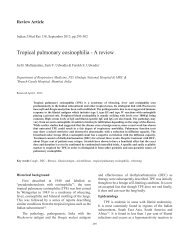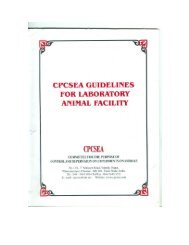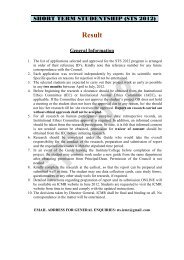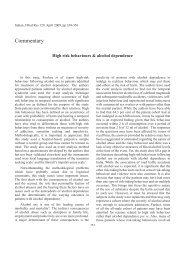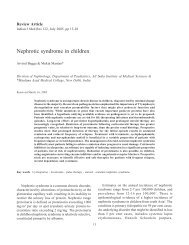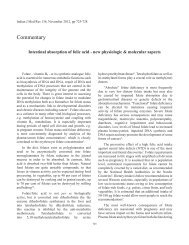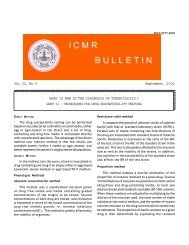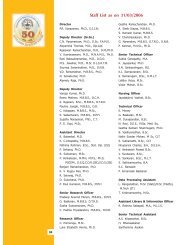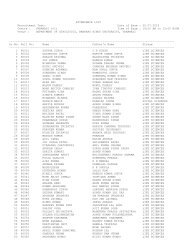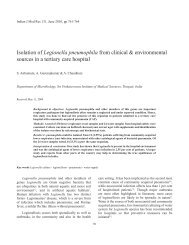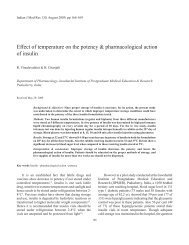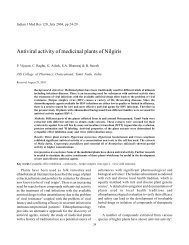7 - Indian Council of Medical Research
7 - Indian Council of Medical Research
7 - Indian Council of Medical Research
Create successful ePaper yourself
Turn your PDF publications into a flip-book with our unique Google optimized e-Paper software.
<strong>Indian</strong> J Med Res 117, March 2003, pp 104-110<br />
A long-term study on vector abundance & seasonal prevalence<br />
in relation to the occurrence <strong>of</strong> Japanese encephalitis<br />
in Gorakhpur district, Uttar Pradesh<br />
P.C. Kanojia, P.S. Shetty & G. Geevarghese<br />
National Institute <strong>of</strong> Virology (ICMR), Pune, India<br />
Received April 26, 2002<br />
Background & objectives: Japanese encephalitis (JE) virus is an important cause <strong>of</strong> viral encephalitis in<br />
Gorakhpur district, UP. The area has been experiencing outbreaks <strong>of</strong> JE since 1978. No in-depth<br />
longitudinal studies have been carried out on the mosquito species, particularly JE vectors prevailing<br />
in the area. Entomological studies were carried out in the district in order to determine the species<br />
composition, relative abundance and seasonal prevalence <strong>of</strong> mosquitoes in relation to the incidence <strong>of</strong><br />
JE.<br />
Methods: Three JE affected villages were selected as study sites. Weekly visits were made to each<br />
village and mosquito collections were made in and around the pig enclosures and cattle sheds with the<br />
help <strong>of</strong> mouth aspirators, aided by flash lights at dusk.<br />
Results: The overall mosquito population showed a bimodal pattern with short and tall peaks during<br />
March and September respectively. Based on the elevated density and infection with JE virus, Culex<br />
tritaeniorhynchus has been considered responsible for causing epidemics in the area. Cx. pseudovishnui,<br />
Cx. whitmorei, Cx. gelidus, Cx. epidesmus, Anopheles subpictus, An. peditaeniatus and Mansonia uniformis<br />
are suspected to have played some role in the epidemiology <strong>of</strong> JE in the region. JE cases were reported<br />
between August and November with the peak in October when the vectors population, particularly<br />
Cx. tritaeniorhynchus was on the decline.<br />
Interpretation & conclusion: The results <strong>of</strong> the study indicate that Cx. tritaeniorhynchus, the most likely<br />
vector <strong>of</strong> JE together with other known vector species remained more active during the period <strong>of</strong><br />
paddy cultivation. Integrated antilarval measures before the beginning <strong>of</strong> paddy irrigation may check<br />
the breeding <strong>of</strong> JE vectors in the paddy fields. It may prove beneficial in reducing the vector population<br />
during the JE transmission season.<br />
Key words Culex tritaeniorhynchus - Cx. pseudovishnui - Gorakhpur district - Japanese encephalitis - JE transmission period -<br />
vector abundance - vectors <strong>of</strong> JE<br />
Japanese encephalitis (JE) virus is the most<br />
important and widespread flavivirus in terms <strong>of</strong><br />
human morbidity and mortality. Approximately<br />
50,000 sporadic and epidemic cases <strong>of</strong> JE are<br />
reported annually in Asia, including India 1 . In<br />
104<br />
Gorakhpur, JE virus has been the leading cause <strong>of</strong><br />
encephalitis in humans. This district has experienced<br />
two major outbreaks <strong>of</strong> JE, first in 1978 and another<br />
in 1988 which claimed hundreds <strong>of</strong> human lives 2,3 .<br />
For the last 40 years, Gorakhpur district has
KANOJIA et al : JE & ITS VECTORS IN GORAKHPUR DISTRICT 105<br />
undergone a lot <strong>of</strong> ecological changes in the form <strong>of</strong><br />
construction <strong>of</strong> irrigation canals and small dams.<br />
The habitats have been modified for development <strong>of</strong><br />
agriculture in the region which has resulted in the<br />
vast expansion <strong>of</strong> water bodies which support<br />
mosquito breeding. These environmental changes<br />
probably have triggered JE in the region. Information<br />
available on the mosquito species, particularly JE<br />
vectors prevailing in Gorakhpur district is scanty.<br />
Sixteen culicine species were recorded in 1961 4 , but<br />
not in relation to the occurrence <strong>of</strong> JE. Nine species,<br />
including 5 JE vectors were documented while<br />
conducting entomological studies during the<br />
declining phase <strong>of</strong> the JE outbreak reported in 1985,<br />
however, this study provides little information on<br />
the endophilic behaviour <strong>of</strong> JE vectors 5 . Barring this,<br />
no detail information is available on the<br />
entomological aspect <strong>of</strong> JE in the district, which is<br />
known for its JE endemicity. In view <strong>of</strong> this,<br />
entomological studies were carried out in order to<br />
determine species composition, relative abundance<br />
and seasonal prevalence <strong>of</strong> mosquitoes in relation to<br />
the occurrence <strong>of</strong> JE in the district. The present<br />
paper reports the results <strong>of</strong> the study carried out<br />
from 1990 to 1996.<br />
Material & Methods<br />
Description <strong>of</strong> the area: Gorakhpur district has an<br />
area <strong>of</strong> about 3483.1 km 2 with a population <strong>of</strong> about<br />
30.66 lakhs with an average density <strong>of</strong> about 880<br />
persons/km 2 . Paddy is cultivated during the monsoon<br />
season. Out <strong>of</strong> 410721 hectares <strong>of</strong> cultivable land,<br />
154601 (37.64%) were under paddy cultivation<br />
(Gorakhpur district agriculture booklet 1990-91).<br />
The harvesting <strong>of</strong> paddy is completed by the middle<br />
<strong>of</strong> October, and wheat and gram are grown during<br />
the subsequent months. Sugarcane is an annual crop<br />
in the area. The year can be broadly divided into<br />
three seasons: summer (March to May), monsoon<br />
(June to September) and winter (October to<br />
February). The area receives a total annual rainfall<br />
varying from 807 to 1564 mm. Floods, water<br />
logging and formation <strong>of</strong> shallow ponds are annual<br />
features in the region.<br />
Mosquito collections: Three villages viz., Bhathat<br />
under Bhathat Primary Health Centre (PHC) area,<br />
Kusmi-takia under Pipraich PHC area and Naharpur<br />
under Chargawan PHC area, were selected for<br />
regular mosquito collection. Each PHC covered<br />
more than one lakh human population. These study<br />
sites were chosen on the basis <strong>of</strong> past records <strong>of</strong> JE,<br />
presence <strong>of</strong> pigs and cultivation <strong>of</strong> paddy in the area.<br />
Weekly visits were made to each village and<br />
mosquito collections were carried out in and around<br />
pig enclosures and cattle sheds at dusk i.e., from<br />
1915 to 2015 and 1750 to 1850 h during summer<br />
and winter respectively with the help <strong>of</strong> mouth<br />
aspirators, aided by torch lights. For monitoring<br />
mosquito population, this type <strong>of</strong> sampling method<br />
is considered superior quantitively as well as<br />
qualitatively 6-8 .<br />
Results<br />
A total <strong>of</strong> 271355 mosquitoes belonging to 48<br />
species and seven genera were collected in 3032<br />
man hours. Fourteen species formed 98 per cent <strong>of</strong><br />
the total catch. In order <strong>of</strong> preponderance these<br />
were: Cx. quinquefasciatus (25.3%), Cx.<br />
tritaeniorhynchus (23.9%), Cx. pseudovishnui<br />
(10.9%), An. subpictus (10.7%), Mansonia uniformis<br />
(7.0%), An. peditaeniatus (4.9%), Cx. gelidus<br />
(3.2%), Cx. whitmorei (3.0%), Cx. epidesmus<br />
(2.1%), An. annularis (2.0%), An. vagus (1.5%),<br />
Aedes lineatopennis (1.4%), Cx. fuscocephala<br />
(1.2%) and Armigeres subalbatus (1.0%).<br />
Percentages <strong>of</strong> some <strong>of</strong> the predominant species are<br />
shown in the Table. The remaining 34 species,<br />
which accounted for two per cent <strong>of</strong> the total catch<br />
were: An. aconitus, An. barbirostris, An. culicifacies,<br />
An. nigerrimus, An. pallidus, An. stephensi, An.<br />
varuna, An . tessellatus, Ae. albopictus, Ae.<br />
assamensis, Ae. indicus, Ae. jamesi, Ae.<br />
pallidostriatus, Ae. pampangensis, Ae. pipersalatus,<br />
Ae. punctifemoris, Ae. scatophagoides, Ae.<br />
taeniorhynchoides, Ae. yusafi, Aedomiya venustipes,<br />
Cx. bitaeniorhynchus, Cx. cornutus, Cx. fuscanus,<br />
Cx. infula, Cx. (lophoceraomyia) species, Cx.<br />
malayi, Cx. sinensis, Cx. sitiens, Cx. vishnui, Ma.<br />
annulifera, Ma. crassipes, Ma. indiana, Mimomyia<br />
chamberlaini and Mi. luzonensis.<br />
Seasonal population fluctuations: The seasonal<br />
fluctuations in the general mosquito population
106 INDIAN J MED RES, MA RCH 2003<br />
Table. Percentage <strong>of</strong> some predominant species <strong>of</strong> mosquitoes collected between 1990 and 1996 in Gorakhpur district, UP<br />
Mosquito species 1990 1991 1992 1993 1994 1995 1996<br />
Culex tritaeniorhynchus 22.9 19.3 24.9 25.8 24.3 27.2 22.1<br />
Cx. pseudovishnui 13.0 10.0 13.8 10.4 11.7 9.8 7.4<br />
Cx. gelidus 3.6 4.3 2.7 3.0 3.2 1.7 4.2<br />
Cx. whitmorei 3.6 1.9 2.4 4.6 1.3 2.2 3.7<br />
Cx. quinquefasciatus 26.2 25.5 16.8 18.1 32.5 27.6 33.4<br />
Anopheles peditaeniatus 2.9 4.6 4.2 6.4 3.7 6.2 6.0<br />
An. subpictus 8.4 14.8 15.6 9.9 9.5 10.2 7.6<br />
Mansonia uniformis 5.8 7.6 8.4 9.0 4.2 7.0 6.0<br />
Total 47660 34439 35337 50372 31234 36300 36013<br />
recorded during the entire study period are shown<br />
in Fig. 1. The combined mosquito population<br />
followed a bimodal pattern. A short early summer<br />
peak was observed in March mainly due to the<br />
high prevalence<br />
<strong>of</strong> Cx. quinquefasciatus. Later, a tall late monsoon<br />
peak was noticed in September chiefly due to the<br />
high density <strong>of</strong> Cx. tritaeniorhynchus. The same<br />
seasonal pattern was observed in all the years<br />
except<br />
Fig. 1. Combined mosquito density in relation to the rainfall, temperature and incidence <strong>of</strong> JE.
KANOJIA et al : JE & ITS VECTORS IN GORAKHPUR DISTRICT 107<br />
in 1994 where the second peak was recorded in<br />
October instead <strong>of</strong> September. The other culicine<br />
species such as Cx. pseudovishnui, Cx. whitmorei, Cx.<br />
gelidus and Ma. uniformis had also shown peak<br />
occurrence in September. The seasonal prevalence <strong>of</strong><br />
some <strong>of</strong> the Culex species is shown in Fig. 2. Among<br />
the Anopheline species, An. subpictus and An.<br />
peditaeniatus showed high prevalence during July and<br />
September respectively.<br />
During the JE transmission period, Cx.<br />
tritaeniorhynchus was the predominant species,<br />
constituting 32 per cent <strong>of</strong> the total catch. This was<br />
followed by Cx. pseudovishnui (16.3%), Ma. uniformis<br />
(11.0%), An. peditaeniatus, (8.6%), An. subpictus,<br />
(5.7%), Cx. whitmorei (5.0%), Cx. gelidus, (5.0%), Cx.<br />
epidesmus (3.1%), and Cx. fuscocephala (1.7%).<br />
Epidemiological features: A total <strong>of</strong> 885 JE cases were<br />
reported from the 20 PHCs <strong>of</strong> the district between<br />
1990 and 1996 (JE cell, district hospital,<br />
Fig. 2. Seasonal abundance <strong>of</strong> Culex species.<br />
Gorakhpur). The maximum number <strong>of</strong> cases<br />
(313) were registered in 1991. Nagar Mahapalika<br />
PHC was the worst affected and 142 JE cases<br />
were reported from this area followed by<br />
Chargawan (116), Pipraich (90), Sardarnagar (79),<br />
Bhathat (71), Jangal Kodia (37), Khorabar (36),<br />
Gaugaha (32), Kauri Ram (29), Bansgaon (28),<br />
Sahjanawa (28), Campierganj (27), Derwa (26),<br />
Piprauli (26), Brahmpur (25), Gola (24), Khajani<br />
(19), Uruwa (16), Belghat (13), Pali (12) and<br />
untraced (9). Generally, cases were reported<br />
between August and November with a peak in<br />
October. But during 1995 and 1996 cases were<br />
reported a little earlier i.e., in June and July<br />
respectively. During 1990, the epidemic<br />
prolonged up to December. Age-wise analysis<br />
revealed that the maximum number <strong>of</strong> cases<br />
occurred in children aged between 1 and 15 yr<br />
with the highest occurrence in the age group 6-10<br />
yr. It was also observed that males were more<br />
affected than females. The epidemics were<br />
usually preceded by substantial rainfall followed<br />
by an elevation in mosquito population.
108 INDIAN J MED RES, MARCH 2003<br />
Discussion<br />
The combined mosquito population showed two<br />
density peaks, one a short peak in March where<br />
Cx. quinquefasciatus contributed in large measure<br />
to the total density. The population <strong>of</strong> this species<br />
increases during March due to the availability <strong>of</strong><br />
favourable breeding sites containing stagnant water<br />
polluted with decayed organic matter. Another tall<br />
peak was observed in September in which<br />
Cx. tritaeniorhynchus was the main contributor.<br />
This species is known to breed in paddy fields and<br />
its abundance is related to rice cultivation. In<br />
Gorakhpur, a single paddy crop is grown and as a<br />
result the majority <strong>of</strong> JE vectors have shown one<br />
peak in a year i.e., in September. The occurrence <strong>of</strong><br />
JE in the region was closely associated with this<br />
peak. Similarly, a peak <strong>of</strong> JE vectors was observed<br />
in the Kolar district <strong>of</strong> Karnataka where a single<br />
paddy crop was raised (NIV, unpublished data). But<br />
two peaks <strong>of</strong> JE vectors were recorded in the areas<br />
where double paddy crops were cultivated in South<br />
Arcot and Madurai districts <strong>of</strong> Tamil Nadu 9,10 .<br />
During the JE transmission period, Cx.<br />
tritaeniorhynchus was the most abundant species and<br />
constituted 32 per cent <strong>of</strong> the total collection. The<br />
major proportionate contribution <strong>of</strong> this species has<br />
been found to be a typical feature in several JE<br />
affected areas in India 7,8,11,12 Cx. tritaeniorhynchus<br />
has also been incriminated as a major vector <strong>of</strong> JE<br />
in India as well as in many countries <strong>of</strong> Southeast<br />
Asia 13-17 . JE cases were first reported in August,<br />
coincided with the high density <strong>of</strong> mosquitoes,<br />
chiefly contributed by Cx. tritaeniorhynchus.<br />
Generally, the epidemics reached their peak during<br />
October, which coincided with a decline in the<br />
general mosquito population, particularly Cx.<br />
tritaeniorhynchus. Such a relationship between the<br />
epidemic and declining vector population has also<br />
been observed in Japan and this type <strong>of</strong> pattern was<br />
attributed to the differences in total and infected<br />
populations <strong>of</strong> vector species 18 . Predominance <strong>of</strong> the<br />
vector species prior to the occurrence <strong>of</strong> the<br />
epidemic might hasten the enzootic infection and<br />
result in a large number <strong>of</strong> infected mosquitoes being<br />
present in the population 8 . One isolate <strong>of</strong> JE virus<br />
was obtained from Cx. tritaeniorhynchus during the<br />
study period 19 . In view <strong>of</strong> its abundance and large<br />
number <strong>of</strong> virus isolates that have been made in<br />
India and elsewhere in Southeast Asia, this species<br />
is likely to be a vector <strong>of</strong> JE virus in Gorakhpur<br />
district.<br />
Cx. pseudovishnui was the second most abundant<br />
species encountered during the JE transmission<br />
period. This species is considered to be an important<br />
vector <strong>of</strong> JE in India and Sri Lanka 20,21 .<br />
Cx. whitmorei and Cx. gelidus were the other<br />
abundant species caught during the JE transmission<br />
period. Cx. whitmorei is considered to be a<br />
secondary vector <strong>of</strong> JE in India and Sri Lanka, where<br />
few isolates <strong>of</strong> JE virus have been obtained 21,22 .<br />
Cx. gelidus has been recognized as the most<br />
important vector <strong>of</strong> JE in Sri Lanka, Thailand,<br />
Malaysia, Vietnam and Sarawak 16,17,21,23,24 . But<br />
relatively few isolations have been made from this<br />
species in India 9,25 . Recently, JE virus has been<br />
isolated from Cx. gelidus in Australia 26 .<br />
Cx. fuscocephala was also collected in<br />
appreciable density during the JE transmission<br />
period. This species is an efficient vector <strong>of</strong> JE in<br />
Thailand 27 . Experimental transmission studies<br />
carried out in that country demonstrated its high<br />
vector efficiency 28 . Isolations from field caught<br />
specimen have been reported from India 9,25 . But<br />
vector competence studies on Cx. fuscocephala<br />
failed to prove its transmission capability though<br />
mosquitoes got infected with JE virus (NIV<br />
unpublished data). Hence, it seems that this species<br />
may differ in its susceptibility in different<br />
geographical areas. The other known vectors <strong>of</strong> JE<br />
in India viz., Cx. epidesmus, An. subpictus, An.<br />
peditaeniatus and Ma. uniformis 29 were also caught<br />
in good numbers during the JE transmission season.<br />
This suggests that all these species may be playing<br />
some role in the epidemiology <strong>of</strong> JE in the area. Cx.<br />
quinquefasciatus was found to be the predominant<br />
species during the drier months <strong>of</strong> the year. A few<br />
isolates <strong>of</strong> JE virus have been made from this species<br />
in India and Vietnam 24,25 but the species is regarded<br />
as a poor vector <strong>of</strong> JE 30 .<br />
Surface water bodies like ponds and tanks are the<br />
perennial breeding sources. Antilarval applications
KANOJIA et al : JE & ITS VECTORS IN GORAKHPUR DISTRICT 109<br />
<strong>of</strong> chemical larvicides (organophosphate),<br />
larvivorous fish (Gambusia affinis) and biological<br />
larvicides (Bacillus thuringiensis) to all the<br />
permanent water bodies before the commencement<br />
<strong>of</strong> paddy irrigation may check proliferation <strong>of</strong><br />
breeding <strong>of</strong> Cx. tritaeniorhynchus as well as other<br />
JE vectors in the rice fields and may contain the<br />
vector population during JE transmission season.<br />
Acknowledgment<br />
Authors thank Dr D.A. Gadkari, former Director and<br />
Dr V.S. Padbidri, former Officer-in-charge, NIV, Pune for<br />
encouragement and advice. The assistance rendered by the field<br />
staff <strong>of</strong> the NIV, Field Station, Gorakhpur is also gratefully<br />
acknowledged. Authors also thank the Chief <strong>Medical</strong> Officer,<br />
District Hospital, Gorakhpur for providing epidemiological data<br />
on encephalitis cases and the Director, Meteorological Centre,<br />
Lucknow and India Meterological Department, Pune for<br />
providing the meteorological data <strong>of</strong> Gorakhpur district.<br />
References<br />
1. Burke DS, Leake CJ. Japanese encephalitis. In: Monath<br />
TP, editor. The arboviruses: epidemiology and ecology,<br />
vol. 3. Boca Raton, Florida: CRC Press; 1988 p. 63-92.<br />
2. Khare JB. Current status <strong>of</strong> Japanese encephalitis in Uttar<br />
Pradesh. In: National Conference on Japanese<br />
Encephalitis . New Delhi : <strong>Indian</strong> <strong>Council</strong> <strong>of</strong> <strong>Medical</strong><br />
<strong>Research</strong>; 1984 p. 22-4.<br />
3. Narasimham MVVL, Rao CK, Bendle MS, Yadava RK,<br />
Johri YC, Pandey RS. Epidemiological investigation on<br />
Japanese encephalitis outbreak in Uttar Pradesh during<br />
1988. J Commun Dis 1988; 20 : 263-75.<br />
4. Chand D, Singh MV, Srivastava BB. Culicine fauna <strong>of</strong><br />
Gorakhpur district (Uttar Pradesh). <strong>Indian</strong> J Malariol<br />
1961; 15 : 313-20.<br />
5. Saxena VK, Baig MH, Bhardwaj M, Rajagopal K.<br />
Entomological investigations <strong>of</strong> Japanese encephalitis<br />
outbreak in Gorakhpur and Deoria districts <strong>of</strong> Uttar<br />
Pradesh. J Commun Dis 1986; 18 : 219-21.<br />
6. Mitchell CJ, Chen PS. Ecological studies on the mosquito<br />
vectors <strong>of</strong> Japanese encephalitis. Bull World Health Organ<br />
1973; 49: 287-92.<br />
7. Geevarghese G, Mishra AC, Jacob PG, Bhat HR. Studies<br />
on the mosquito vectors <strong>of</strong> Japanese encephalitis virus in<br />
Mandya district, Karnataka, India. Southeast Asian J Trop<br />
Med Public Health 1994; 25 : 378-82.<br />
8. Mishra AC, Jacob PG, Ramanujam S, Bhat HR, Pavri KM.<br />
Mosquito vectors <strong>of</strong> Japanese encephalitis epidemic (1983)<br />
in Mandya district (India). <strong>Indian</strong> J Med Res 1984; 80 :<br />
377-89.<br />
9. Gajanana A, Rajendran R, Samuel PP, Thenmozhi V, Tsai<br />
TF, Kimura - Kuroda J, et al. Japanese encephalitis in<br />
South Arcot district, Tamil Nadu, India : a three - year<br />
longitudinal study <strong>of</strong> vector abundance and infection<br />
frequency. J Med Entomol 1997; 34 : 651-9.<br />
10. Mani TR, Rao CV, Rajendran R, Devaputra M, Prasanna<br />
Y, Hanumaiah A, et al. Surveillance for Japanese<br />
encephalitis in villages near Madurai, Tamil Nadu, India.<br />
Trans R Soc Trop Med Hyg 1991; 85 : 287-91.<br />
11. National Institute <strong>of</strong> Virology, Pune. Japanese encephalitis<br />
in India : Information Document; 1980 p. 1-62.<br />
12. Soman RS, Kaul HN, Guru PY, Modi GB, Guttikar SN,<br />
Dhanda V. A report on the mosquitoes collected during an<br />
epidemic <strong>of</strong> encephalitis in Burdwan and Bankura districts,<br />
West Bengal. <strong>Indian</strong> J Med Res 1976; 64 : 808-13.<br />
13. Rodrigues FM. Epidemiology <strong>of</strong> Japanese encephalitis in<br />
India: A brief overview. In: Proceedings <strong>of</strong> the National<br />
Conference on Japanese Encephalitis. New Delhi: <strong>Indian</strong><br />
<strong>Council</strong> <strong>of</strong> <strong>Medical</strong> <strong>Research</strong>; 1984 p. 1-9.<br />
14. Leake CJ, Ussery MA, Nisalak A, Hoke CH, Andre RG,<br />
Burke DS. Virus isolations from mosquitoes collected<br />
during the 1982 Japanese encephalitis epidemic in northern<br />
Thailand. Trans R Soc Trop Med Hyg 1986; 80 : 831-7.<br />
15. Amerasinghe FP, Peiris JS, Karunaratne SH, Amerasinghe<br />
PH. Epidemiology <strong>of</strong> the 1987 Japanese encephalitis<br />
outbreak in Anuradhapura area. II. Entomological aspects.<br />
Proc Sri Lanka Med Assoc 1988; 101 : 22-3.<br />
16. Gingrich JB, Nisalak A, Latendresse JR, Sattabongkot J,<br />
Hoke CH, Pomsdhit J, et al. Japanese encephalitis virus in<br />
Bangkok: factors influencing vector infections in three<br />
suburban communities. J Med Entomol 1992; 29 : 436-44.<br />
17. Macdonald WW, Smith CE, Dawson PS, Ganapathi Pillai<br />
A, Mahadevan S. Arbovirus infections in Sarawak: further<br />
observations on mosquitoes. J Med Entomol 1967; 4 :<br />
146-57.<br />
18. Buescher EL, Scherer WF, Rosenberg MZ, Gresser I, Hardy<br />
JL, Bullock HR. Ecologic studies <strong>of</strong> Japanese encephalitis<br />
virus in Japan. II. Mosquito infection. Am J Trop Med<br />
Hyg 1959; 8 : 651-64.<br />
19. Pant U, Ilkal MA, Soman RS, Shetty PS, Kanojia PC, Kaul<br />
HN. First isolation <strong>of</strong> Japanese encephalitis virus from the<br />
mosquito, Culex tritaeniorhynchus Giles, 1901 (Diptera:<br />
Culicidae) in Gorakhpur district, Uttar Pradesh. <strong>Indian</strong> J<br />
Med Res 1994; 99 : 149-51.<br />
20. George S, Jacob PG, Rao JA. Isolation <strong>of</strong> Japanese<br />
encephalitis and West Nile viruses from mosquitoes<br />
collected in Kolar District <strong>of</strong> Karnataka state during<br />
1977-79. <strong>Indian</strong> J Med Res 1987; 85 : 235-8.<br />
21. Peiris JS, Amerasinghe FP, Arunagiri CK, Perera LP,<br />
Karunaratne SH, Ratnayake CB, et al. Japanese<br />
encephalitis in Sri Lanka: comparison <strong>of</strong> vector and virus<br />
ecology in different agro-climatic areas. Trans R Soc Trop<br />
Med Hyg 1993; 87 : 541-8.
110 INDIAN J MED RES, MARCH 2003<br />
22. Banerjee K, Rodrigues FM, Dhanda V. Strategy for the<br />
control <strong>of</strong> Japanese encephalitis. ICMR Bull 1988; 18 :<br />
75-82.<br />
23. Gould DJ, Barnett HC, Suyemoto W. Transmission <strong>of</strong><br />
Japanese encephalitis virus by Culex gelidus Theobald.<br />
Trans R Soc Trop Med Hyg 1962; 56 : 429-35.<br />
24. Thoa NT, Vien NT, Mai TT, Xuan NT. Japanese<br />
encephalitis vectors: Isolation <strong>of</strong> virus from culicine<br />
mosquitoes in the Saigon area. Southeast Asian J Trop<br />
Med Public Health 1974; 5 : 408-12.<br />
25. Mourya DT, Ilkal MA, Mishra AC, Jacob PG, Pant U,<br />
Ramanujam S, et al. Isolation <strong>of</strong> Japanese encephalitis virus<br />
from mosquitoes collected in Karnataka state, India from<br />
1985 to 1987. Trans R Soc Trop Med Hyg 1989; 83 :<br />
550-2.<br />
26. Van den Hurk AF, Nisbet DJ, Johansen CA, Foley PN,<br />
Ritchie SA, Mackenzie JS. Japanese encephalitis on Badu<br />
Island, Australia: the first isolation <strong>of</strong> Japanese encephalitis<br />
virus from Culex gelidus in the Australasian region and the<br />
role <strong>of</strong> mosquito host-feeding patterns in virus transmission<br />
cycles. Trans R Soc Trop Med Hyg 2001; 95 : 595-600.<br />
27. Gould DJ, Edelman R, Grossman RA, Nisalak A, Sullivan<br />
MF. Study <strong>of</strong> Japanese encephalitis virus in Chiangmai<br />
valley, Thailand. IV. Vector studies. Am J Epidemiol 1974;<br />
100 : 49-56.<br />
28. Muangman D, Edelman R, Sullivan MJ, Gould DJ.<br />
Experimental transmission <strong>of</strong> Japanese encephalitis virus<br />
by Culex fuscocephala. Am J Trop Med Hyg 1972; 21:<br />
482-6.<br />
29. Samuel PP, Hiriyan J, Gajanana A. Japanese encephalitis<br />
virus infection in mosquitoes and its epidemiological<br />
implications. ICMR Bull 2000; 30 : 37-43.<br />
30. Sirivanakarn S. <strong>Medical</strong> entomology Studies - III. A<br />
revision <strong>of</strong> the subgenus Culex in the Oriental Region<br />
(Diptera: Culicidae). Contrib Am Entomol Inst 1976; 12 :<br />
1-272.<br />
Reprint requests : Dr P.C. Kanojia, Assistant Director, National Institute <strong>of</strong> Virology (ICMR), 20-A Dr Ambedkar Road,<br />
Pune 411001, India



